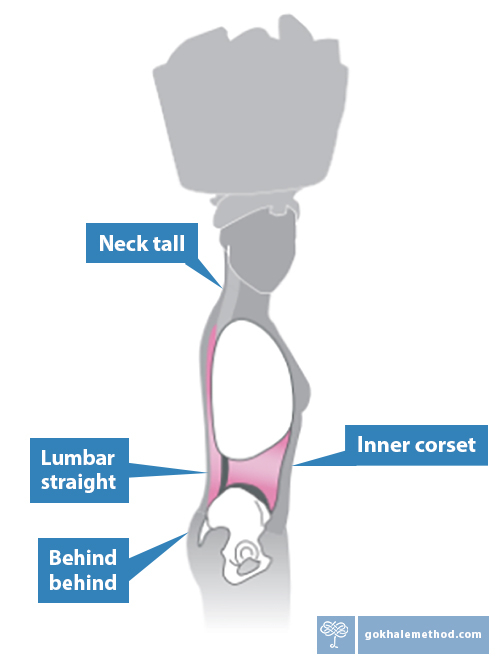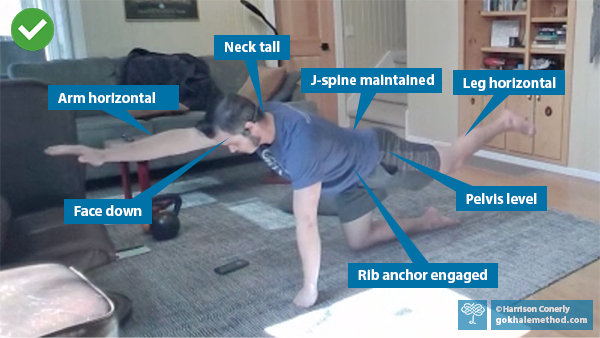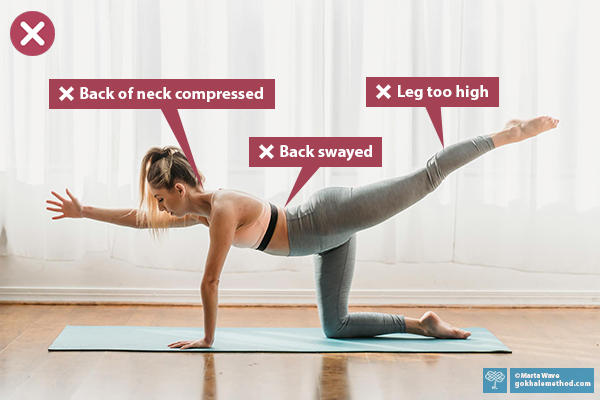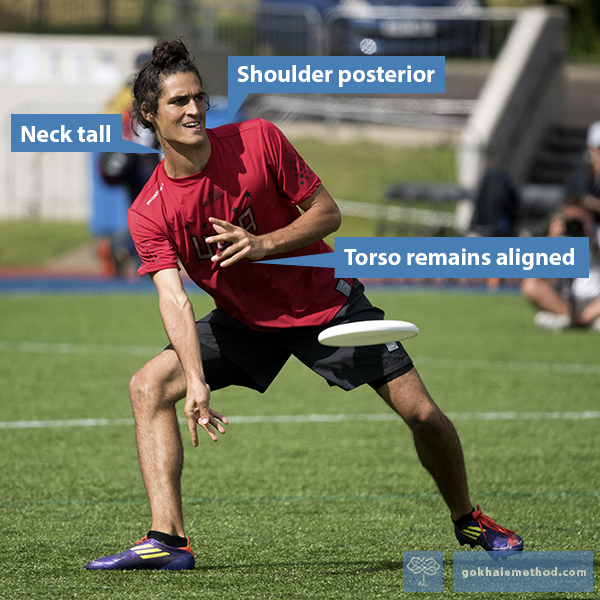Have you been taught cobra pose or locust pose to strengthen your back? It is a common practice to try to strengthen the back with back bends, focusing on the long back extensors on either side of the spine. This approach is used by the McKenzie Method, many yoga teachers, and physical therapists.
In the Gokhale Method® we prefer to strengthen the back by working with the muscles which collectively stabilize the trunk. Our focus is on maintaining a healthy J-spine baseline rather than backbending.

Healthy muscle activation maintains a J-spine, protecting the spine, discs, and nerves from damage due to instability and compression.
Recently in Gokhale® Fitness, our teacher Harrison has been taking our members through an exercise I rate highly, bird dog, or, as it is sometimes called, table top. Contrary to its appearance, it is not primarily a leg and arm exercise—instead, the weight and movement of the limbs provide a challenge to the stability of the torso, strengthening the muscles of the inner corset, which include the transversus abdominus, the internal and external obliques, and the intrinsic muscles of the spine. This then protects the spine against torque and distortion.

Gokhale Fitness teacher Harrison in the basic bird dog pose. Bird dog involves lifting the opposite arm and leg—but its purpose is to work the deep trunk stabilizers, or inner corset.
Most people do this exercise any old way—perhaps with a tucked pelvis, a hung head, or flinging their arms and legs up and swaying their backs. It wants to be done in such a way that it maintains the J-spine and doesn’t encourage distortions of the spine such as excessive lumbar lordosis or thoracic kyphosis, and doesn’t pull your nerves and discs around willy-nilly.
Caution: If your back pain is persistent or severe, we recommend you consult your medical team prior to doing this exercise.
Setting up
Especially if you are new to this exercise, or to the Gokhale Method, take your time to set up well. Without the correct set up, you can lose the exercise’s value from the get-go. You want the exercise to be safe, effective, and to pattern healthy everyday movement mechanics.
- Kidney bean shape your hands (use your fists if you prefer)
- Externally rotate your legs a little
- Pivot your pelvis forward (antevert) by relaxing your lower belly
- Engage your rib anchor to eliminate any sway
- Drop your spine between your shoulder blades
- Lengthen the back of your neck. Your face will be parallel with the floor, your chin down

Check you are starting from a good baseline position.
Doing Bird Dog
Engage your trunk muscles to keep your pelvis and trunk level and still at all times—do not twist, round, or dip.
- Start by lifting one arm, and the opposite leg, outwards to horizontal, in line with your torso.
- Return to the floor.
- Switch sides, lifting and lowering the opposite arm and leg together.
- Repeat on alternate sides.
This video shows the smooth, steady action that you are looking for in bird dog. Your torso remains still and horizontal while you move one leg and the opposite arm, and then change sides.
Reps, sets, and frequency
How many you do depends on your current level of fitness and strength, but for most people up to three sets of 6, 8, or 10 repetitions works well (one raise and lower of an arm and a leg is a rep). Stop short of failure—you don’t want to lose your form, but rather, protect your spine at all times.
If you feel significant soreness in your muscles the next day, give yourself a day to recuperate before repeating bird dog. If you are working at a gentle level, you can do this exercise daily if you wish.
Common mistakes
- Losing your form—keep checking that you haven’t tucked your pelvis, swayed your lower back, rounded your upper back, or arched your neck.
- Doing the exercise too fast, as if it were an arm and leg aerobic exercise rather than a trunk stabilization exercise.
- Lifting your arm and leg too high, and swaying your back.

Lifting the head and/or leg beyond horizontal will likely encourage sway in the back. Image from Pexels
Ways to progress the exercise
After you have mastered good form and smooth execution, you may want to increasingly challenge your muscles. Depending on your starting point this may take a few days, weeks, or months…don’t rush it and risk injury. There are many ways to progress steadily and vary your training:
- If you started with just a few reps, aim to up your reps and/or sets over time. You can count numbers or breaths, or work to music.
- Raising your hand in a fist uses more muscular engagement in the hand and forearm.
- As you extend your leg, use your foot muscles to point your toes. Then try a set pointing your heel back.
- Hold the extension position (lift) to work on stamina and endurance and add an isometric challenge to your muscles. Go for duration rather than lifting beyond horizontal.
- Bring your knee and hand together rather than down to the floor between lifts.
- Add wrist and ankle weights.
In this video Harrison demonstrates adding further challenge in bird dog.
Take the benefits into daily life
No matter how well done, bird dog is only an exercise and can only be done so many times by a sane person. It is, however, perfect preparation for real life activities that use the arms and legs, while needing to keep the trunk steady—e.g. opening a heavy door, carrying a suitcase, lifting something off a high shelf, dancing, or bending. After a week or two of doing this exercise, you will probably notice that you feel stronger and that daily chores are more enjoyable. You may notice your running or swimming is more efficient and powerful. And that you have less back pain!

Trunk stability enables you to undertake asymmetrical tasks which would otherwise distort and injure your spine.
Best next action steps
If you would like guidance in moving as you are meant to, and doing bird dog, or other exercises, with healthy form and posture, book a consultation, online, or in person with one of our teachers.
You can sign up below to join any one of our upcoming FREE Online Workshops…



Comments
It was so wonderful to be
It was so wonderful to be introduced to Harrison & the Bird Dog. I will definitely be looking for more of his examples.
Thank you for the recording. It is always appreciated.
What is an alternative to
What is an alternative to being on the floor on your knees?
It's crucial to prioritize
It's crucial to prioritize proper form and technique when performing any exercise to avoid injury. If you have any existing back conditions or concerns slope, it's advisable to consult with a healthcare professional or a certified trainer who can provide personalized guidance based on your specific needs.